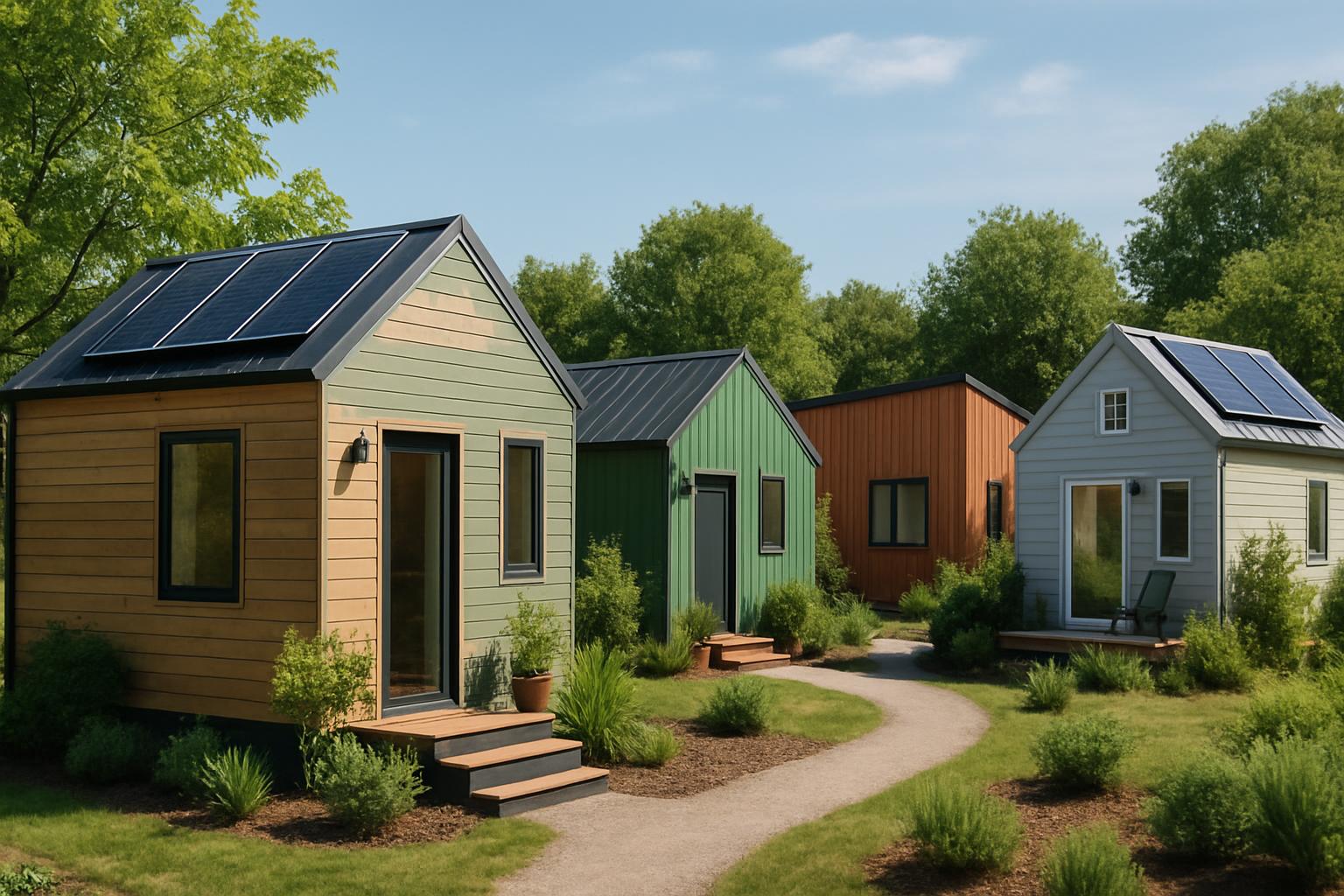
Tiny Home Co-op: Affordable Housing Solutions for 2025
Estimated reading time: 8 minutes
Key Takeaways
- Tiny home co-ops provide a community-driven model that blends shared ownership, affordable living, and sustainable practices.
- Members pool resources, share maintenance costs, and make democratic decisions, reducing individual financial burdens.
- Government support and innovative financing through shared equity housing models are key to addressing Canada’s housing crisis by 2025.
Table of contents
- What is a Tiny Home Co-op? Defining Affordable Housing for 2025
- Understanding the Tiny Home Co-op Structure: Community Building & Affordable Housing
- Shared Equity Housing in Tiny Home Co-ops: Financial Advantages & Long-Term Affordability
- Community Building: The Social & Emotional Benefits of Tiny Home Co-ops
- Affordable Housing: The Role of Tiny Home Co-ops in Addressing 2025’s Housing Crisis
- Sustainability and Practical Benefits: How Tiny Home Co-ops Promote Affordable, Green Living
- How to Get Involved or Start a Tiny Home Co-op: Step-by-Step Guide
- Conclusion: Leading the Way for Shared Equity Housing & Community Building
- Frequently Asked Questions
What is a Tiny Home Co-op? Defining Affordable Housing for 2025
A tiny home co-op is a community-driven housing model where members collectively own or manage a group of small, self-contained dwellings—each typically under 40 square metres. Unlike private ownership or conventional rentals, a tiny home co-op operates on cooperative principles. Residents have a say in how the community is run and share equity and responsibility.
This arrangement means:
- The community jointly owns or manages the property and land.
- Every member usually buys a share, securing the right to live there.
- All major decisions, from maintenance to welcoming new residents, are made democratically.
The draw of co-ownership in a tiny home co-op comes from its unique benefits:
- Shared responsibility reduces the burden on any single member.
- Individual living costs—utilities, maintenance, and land—are lowered because expenses are pooled.
- The compact design and shared ethos of tiny homes promote sustainable, earth-friendly living.
With Canada’s affordable housing crisis expected to peak by 2025, innovative models like the tiny home co-op are gaining attention. Co-ops address rising costs, limited supply, and sustainability—issues that standard housing models struggle to solve. By blending shared equity housing and close-knit community building, tiny home co-ops are reshaping the future of affordable living. For a deeper understanding of shared equity housing, see this resource.
Source: tinyhomeindustryassociation.org & Wikipedia
Understanding the Tiny Home Co-op Structure: Community Building & Affordable Housing
Tiny home co-ops are structured like other housing cooperatives but are uniquely adapted to small, energy-efficient homes. Here’s how the model works:
Legal Structure & Membership
- The group forms a legal cooperative, which can own or manage the community’s land and units.
- Individuals purchase a member share, granting occupancy rights to a specific tiny home.
- Decision-making is democratic: One vote per member.
- Day-to-day operations—repairs, community events, screening new applicants—are managed collectively.
Community Building in Action
- Co-op members routinely participate in maintenance planning and execution.
- They elect a board or committee to guide operations.
- They create policies, such as pet rules or quiet hours, that align with the community’s values.
Tiny Home Co-op vs. Traditional Homeownership or Renting
In traditional ownership/rental:
- Individuals bear the full cost of the home or unit.
- Maintenance and repair decisions rest on the owner or landlord.
- Market pricing dictates costs, often rising steeply.
In a tiny home co-op:
- Costs like land, building maintenance, and utilities are shared, reducing the individual burden.
- Residents enjoy greater housing security as the co-op maintains long-term ownership.
- Shared equity housing models help prevent speculative flipping and runaway price increases.
Pooling resources across a community boosts purchasing power while creating stability and fostering a sense of belonging. For more on community benefits in tiny home living, see this guide.
Source: Wikipedia & CHF Canada
Community Building: The Social & Emotional Benefits of Tiny Home Co-ops
Living in a tiny home co-op is as much about human connection as it is about affordability. Community building is a foundational principle:
- Residents know their neighbours and collaborate on projects like community gardens, childcare, and social gatherings.
- Every member has a voice, ensuring community policies reflect shared values and needs.
- Regular meetings and task-sharing help reduce isolation and build trust.
Why Community Building Matters
- Shared responsibilities, from cleaning to maintenance, deepen commitment to the co-op’s success.
- Members often establish mutual support networks, lending tools and checking in on each other.
Real-World Examples of Community Building
Although dedicated tiny home co-op case studies are emerging, similar models like student housing co-ops and intentional shared housing in cities such as Vancouver and Montreal illustrate:
- High resident satisfaction through a strong sense of belonging.
- Fewer evictions and relocations because members are financially and emotionally invested.
- Robust participation in governance and community development.
These facets contribute to long-term stability and fulfillment missing in traditional housing. See this example for more on community benefits.
Source: Wikipedia & CHF Canada
Affordable Housing: The Role of Tiny Home Co-ops in Addressing 2025’s Housing Crisis
Canada is facing an acute shortage of affordable housing affecting young adults, seniors, and middle-income families alike. This crisis is driven by:
- Soon-to-be soaring housing prices in urban centres.
- A limited supply of affordable rental and ownership options in rural areas.
- Declining vacancy rates and stagnant construction of affordable housing units.
How Tiny Home Co-ops Tackle These Challenges
Government Support and New Policy Initiatives
- In 2024, the federal government launched the Co-op Housing Development Program, earmarking at least $1.5 billion for cooperative housing projects through 2028.
- This program targets energy-efficient and accessible co-ops—including tiny home models.
- Policies now recognize co-op housing as a sustainable, scalable housing solution, easing permit and financing processes.
What’s Different About Tiny Home Co-ops?
- They maximize land and material efficiency to increase the number of affordable homes on a site.
- Their compact design and shared infrastructures help keep both building and operational costs low.
- Community-driven management makes them inclusive and responsive to resident needs.
By leveraging these factors, tiny home co-ops are poised to be a cornerstone of Canada’s affordable housing strategy as we approach 2025. For further context on affordable housing programs, visit this resource.
Source: Cooperatives First & CMHC
Sustainability and Practical Benefits: How Tiny Home Co-ops Promote Affordable, Green Living
Environmental Advantages
- Tiny homes require fewer raw materials, less energy for heating and cooling, and occupy a smaller footprint compared to traditional homes.
- In a co-op setting, eco-friendly solutions like solar panels, rainwater collection, composting, and shared gardens are more feasible.
- Community rules can encourage energy-efficient practices and technologies.
Practical Sustainability Benefits
- Lower monthly utility expenses due to efficient design and shared resources.
- Efficient land use opens up space for community gardens and green zones.
- Reduced waste generation through group purchasing and shared resources.
Social & Financial Returns
- Sustainable living not only cuts costs but also strengthens community bonds.
- Residents benefit directly from reduced environmental impact and shared investments in eco-friendly infrastructure.
This holistic approach makes tiny home co-ops a leader in affordable and sustainable living. For more on eco-friendly tiny home living, visit this page.
Source: tinyhomeindustryassociation.org
How to Get Involved or Start a Tiny Home Co-op: Step-by-Step Guide
For those interested in joining or launching a tiny home co-op, a clear path awaits. Follow this checklist:
Step 1: Gather Your Team and Vision
- Form an organizing group with like-minded individuals who share common values and objectives.
- Define your vision, including affordability targets, sustainability goals, and necessary amenities.
Step 2: Legally Incorporate as a Cooperative
- Research provincial or territorial regulations regarding cooperative incorporation.
- Utilize guides from co-op organizations for drafting bylaws, applications, and governance templates.
Step 3: Connect with Co-op Sector Organizations
- Engage with groups like CHF Canada and local co-op federations for mentorship and resources.
Step 4: Develop a Business & Community Governance Plan
- Create a comprehensive business plan outlining projected budgets, funding sources, onboarding procedures, and community guidelines.
Step 5: Secure Funding
- Apply for federal, provincial, and municipal funding—especially via the Co-op Housing Development Program.
- Collaborate with credit unions or ethical lenders experienced in cooperative housing projects.
Step 6: Find and Prepare a Site
- Select land that meets the budget, zoning, and community needs.
- Consult with tiny home construction experts and urban planners familiar with co-op developments.
Step 7: Build, Acquire, or Retrofit Tiny Home Units
- Work with experienced builders to meet the technical and legal requirements of tiny home communities.
- Plan for common facilities like laundry, storage, gardens, or playgrounds, ensuring accessibility where needed.
For further guidance, visit CHF Canada’s startup guide.
Source: CHF Canada, Cooperatives First & CMHC
Conclusion: Tiny Home Co-op—Leading the Way for Shared Equity Housing & Affordable Community Building in 2025
Tiny home co-ops uniquely blend shared equity housing with community-driven management to provide practical, affordable housing solutions. They:
- Utilize cooperative structures to lower costs and enhance housing security.
- Offer financial and social benefits through shared equity and democratic decision-making.
- Combat isolation with supportive community practices and mutual aid.
- Leverage new federal investments and policy support to grow as a solution to the looming housing crisis.
- Promote sustainable, efficient living while reducing environmental impacts.
Tiny home co-ops are more than just a response to the housing shortage; they represent a forward-thinking approach to sustainable, community-focused development. Now is the perfect moment to join or launch a tiny home co-op and help build an affordable, sustainable future for 2025 and beyond.
Sources: Cooperatives First, CMHC & CHF Canada
Frequently Asked Questions
Q: What exactly is a tiny home co-op?
A: It’s a cooperative housing model where members own or manage a community of compact homes, sharing both costs and responsibilities.
Q: How does shared equity housing work in a co-op?
A: Residents buy a share that gives them occupancy rights, with strict rules to prevent excessive price hikes on resale, ensuring long-term affordability.
Q: What are the main benefits of living in a tiny home co-op?
A: Beyond affordability, residents enjoy lower utility and maintenance costs, a stronger sense of community, and sustainable living practices.
Q: How can I get involved or start my own tiny home co-op?
A: Begin by gathering a like-minded group, research legal requirements, secure funding, and consult guides from organizations such as CHF Canada.

Leave a Reply